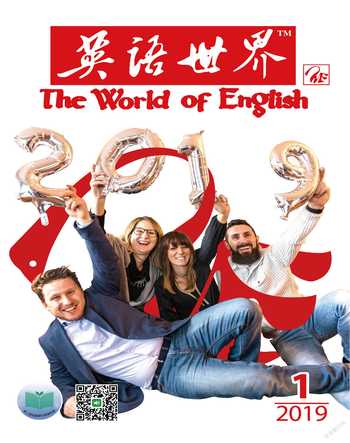How a Prehistoric Fruit Wound Up at Your Super Bowl Party?史前水果何以风靡“超级碗”派对?
丹尼尔·斯通
Marketing and fads lifted the ancient avocado1 to popularity. 借力營销和消费风尚,古老的牛油果全球走红。
The Super Bowl2 isn’t just a battle of the best football teams. It’s a botanical milestone as well—the day the United States hits peak avocado. Every year for the big game, ravenous3 fans turn more than 65 million avocados into guacamole4, which is remarkable for a prehistoric fruit that might have gone extinct thousands of years ago.
Avocados grew naturally, like all fruits, but endured where others failed by making themselves attractive to large creatures called gomphotheres5, which looked like an elephant mixed with a walrus6. A fruit ensures its survival by spreading its seeds. Gomphotheres could easily pass the avocados’ large seeds through their spacious digestive tracts, distributing them across the landscape.
Eleven thousand years later, the Aztecs7 invented guacamole. “Avocado” comes from the Aztec word “ahuacatl,” a derivative of the word for testicle, based on how the fruit grows droopy and in pairs. The Aztecs also called it the “fertility fruit,” based on their belief that it boosted virility (a finding that modern science hasn’t quite backed up).
An American “food spy8” named David Fairchild9, on assignment for the US Department of Agriculture, picked up the fruit in Chile10 in the 1890s with the intention of introducing it to US farmers and American palates. But today, Mexico is the world’s leading supplier of avocados. When California growing season ends each September, Mexican farmers kick their production into high gear, particularly in the state of Michoacán11, where avocados are so lucrative that some orchards12 are protected by armed guards13.
As with kale or quinoa, one way to explain the avocado renaissance is marketing. Why else would an ancient fruit rather suddenly boom in popularity in—of all places—Brooklyn, where an “avocado bar” called the Avocaderia fills its Instagram feed14 with portraits of sliced avocados in artful compositions?
Avocado production and consumption took off in the 1990s, which coincides with the first big marketing campaigns. The media-savvy Hass Avocado Board15 promotes the fruit as though it were a rock star, publicizing its many health benefits related to immunity, weight loss and cardiovascular disease16. The Hass board shared some of its marketing secrets in a 2015 report, and among them was this unsubtle tip: “Large, illustrated ads create excitement.” That helps explain how avocados ended up with the largest illustrated promotion on the planet, a Super Bowl ad, paid for by industry group Avocados from Mexico17, along with a mobile game that transports users to sunny “Avocadoland” and “Guacapulco.” 18
Chefs are also responsible for innovations that fuel popularity. Avocados are ancient, but the first time The Washington Post mentioned an “avocado smoothie” was in 2000 (in an article about Eden Center, the Vietnamese shopping center in Northern Virginia). “Avocado toast” didn’t come up until 2013. The green flesh is now mushed, salted and mounted on bread at coffee shops across America, and mocked as the bane of millennial savings accounts19.
Demand for avocados shows no sign of declining, and not only in the United States. The Netherlands’ consumption of avocados isn’t far behind America’s, and China’s growing appetite has surged 250 percent each year since 2012. Last spring, a three-week avocado promotion at China’s 5,000 KFC restaurants had to end early when the country ran out.
Can the avocado-producing countries sustain such worldwide zest? So far, yes. But growing exports are pushing Mexican farmers nearly to their limit of land, water and fertilizer. An almost endless number of global customers also pushes the price up, up and up. Last year, the cost in the United States of a single avocado more than doubled—and the fact that they remain hard to keep on store shelves indicates that the price may rise still.
But the future of agriculture is hard to predict by looking to the past. Keeping up with the market requires growing more but also growing more efficiently. Scientists are working on seeds that thrive with less water, in denser orchards and—the real holy grail20—in cooler climates. Apeel Sciences21, a company near Santa Barbara, Calif., is developing ways to make avocados (and other fruits) stay fresh longer, so they can be shipped farther distances, potentially opening up new growing regions, that, like Mexico, can lift their economies on the fruit no one can get enough of.
Which is to say, tomorrow’s avocados won’t be the same as today’s, or probably even consumed in the same way (i.e. as Super Bowl party dip). Just ask David Fairchild, who couldn’t have imagined when he introduced a box of “alligator pears” to the United States 120 years ago that a century in the future, people would be getting avocado tattoos and applying moisturizing avocado face masks. Or better yet, ask the Aztecs, whose avocado sauce never seems to get credit for being the first #AvocadoInnovation.
如今,超级碗不仅是美国最棒的橄榄球队之间的战役,还是植物圈的一大盛事——这一天在美国,牛油果消费量最大。每年超级碗比赛期间,食欲旺盛的球迷吃掉的牛油果醬要消耗6500多万颗牛油果。这对于史前时期便已存在、数千年前几近灭绝的牛油果来说,实在惊人。
和其他水果一样,牛油果也是自然生长的。但在其他水果都无法生存的地方,牛油果通过吸引嵌齿象科动物存活了下来。这类动物的样子很像大象和海象的结合体。水果都通过传播种子延续生命,牛油果也不例外。牛油果的种子比较大,嵌齿象科动物可以借助自身巨大的消化道,轻松将它们传播开来。
1.1万年后,阿兹特克人发明了牛油果酱。avocado这个词源于阿兹特克语ahuacatl一词,该词是从testicle(睾丸)衍生而来,因为牛油果成对生长,果实下垂。另外,阿兹特克人认为牛油果可以壯阳(现代科学还未证实这一观点),因此也称之为“生育之果”。
美国“试吃员”戴维·费尔柴尔德曾任职于美国农业部。19世纪90年代,他在智利找到了这种果实,将其介绍给美国农民种植,让美国人品尝。但是如今,墨西哥却成了全球最大的牛油果供应国。加利福尼亚的牛油果每年9月就下市了。此时,在墨西哥,尤其是米却肯州,正值牛油果丰收季,利润如此之高,一些果园甚至雇用武装人员守卫。
牛油果与羽衣甘蓝、藜麦一样,可以说都是借力市场营销走红。在纽约市的布鲁克林区,有一家叫Avocaderia的“牛油果吧”,这家餐厅的Instagram里,都是摆成精美形状的牛油果切片的图片——正是借力这样的营销,这种古老的水果才偏偏在布鲁克林一炮走红。
上世纪90年代,第一轮大规模营销活动展开,牛油果的生产和消费开始猛增。哈斯牛油果协会借媒体之力,像宣传摇滚巨星那样宣传牛油果,称其可以增强免疫力、帮助减肥、预防心血管疾病,益处多多。哈斯协会在2015年发布的一份报告中分享了一些营销秘诀,里面提到一个常见的营销策略:“生动的巨幅图片广告令人激动。”正因如此,行业组织 “来自墨西哥的牛油果”才选择在超级碗比赛上打广告——这是全球最大的图片广告。另外,它还设计了一款手机游戏为牛油果造势,其中的两个游戏场景 “牛油果之都”和 “瓜卡普尔科”阳光明媚,玩家会有身临其境之感。
厨师的产品创新也推动了牛油果的走红。牛油果史前时期便已存在,但《华盛顿邮报》2000年才首次提到“牛油果奶昔”(在一篇关于伊甸园购物中心的文章中。那是一家越南人开办的商场,位于北弗吉尼亚)。2013年出现了“牛油果吐司”。全美的咖啡厅如今都将牛油果压成泥,加入盐,抹到面包上。有人打趣说,正是因为牛油果吐司,千禧一代的存款额降低了。
对牛油果的需求尚无下降的迹象,而且不仅在美国是这样。荷兰的牛油果消费紧随美国之后,而在中国,牛油果消费从2012年起以每年250%的速度在增长。去年春天,牛油果系列产品促销活动在中国的5000家肯德基门店展开,计划持续3周的活动最后因产品卖光而不得不提早结束。
牛油果生产国能否满足世界各国的狂热需求呢?目前看来,答案是肯定的。但出口不断增长,造成墨西哥的土地、水和肥料也几近饱和。全球消费持续增长,造成牛油果价格一再攀升。去年,美国牛油果单位成本增加了两倍多——但牛油果依旧一上架就被一抢而空,由此可见,价格可能还会继续上涨。
但是依靠以往的情况很难预测未来牛油果种植的发展趋势。若想满足市场的需求,不仅需要提高产量,也需要提高生产效率。科学家正在研发一种牛油果种子,它需水量较低,可以种得更密一些,而且——真正的挑战——能在更为寒冷的气候条件下生长。Apeel Sciences科技公司位于美国加利福尼亚州圣巴巴拉附近,正在研发延长牛油果(以及其他水果)保鲜时间的方法。若研发成功,牛油果可以运输至更远的地方,便有可能开发新的种植区,那些地区就能像墨西哥一样,借牛油果这种供不应求的水果提振当地经济。
也就是说,未来的牛油果将有别于现在的牛油果,甚至消费方式也跟今天不同(即当作超级碗派对上的果酱)。可以问问戴维·费尔柴尔德,120年前,他把一箱“鳄梨”带回美国时,肯定想不到百年之后人们会依照牛油果的样式纹身、敷牛油果补水面膜。或者最好再问问阿兹特克人,他们发明的牛油果酱算是首个“牛油果创新产品”,却似乎永远不会因此而得到赞誉了。
(译者单位:对外经济贸易大学)

